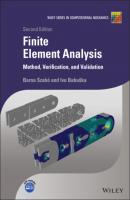Finite Element Analysis. Barna Szabó
Чтение книги онлайн.

Читать онлайн книгу Finite Element Analysis - Barna Szabó страница 43
Название: Finite Element Analysis
Автор: Barna Szabó
Издательство: John Wiley & Sons Limited
Жанр: Физика
isbn: 9781119426462
isbn:
(1.118)
where
Letting
which is plotted for various values of
Figure 1.11 The solution
This is a simple example of boundary layer problems that arise in models of plates, shells and fluid flow. Despite the fact that
The optimal discretization scheme for problems with boundary layers is discussed in the context of the
A practical approach to problems like this is to create an element at the boundary (in higher dimensions a layer of elements) the size of which is controlled by a parameter. The optimal value of that parameter is then selected adaptively.
1.6.2 The exact solution lies in
In this section we consider a special case of the problem stated in eq. (1.103):
(1.120)
with the data
(1.121)
that is,
(1.122)
On integrating by parts, we get the following expression which is better suited for numerical evaluation:
(1.123)